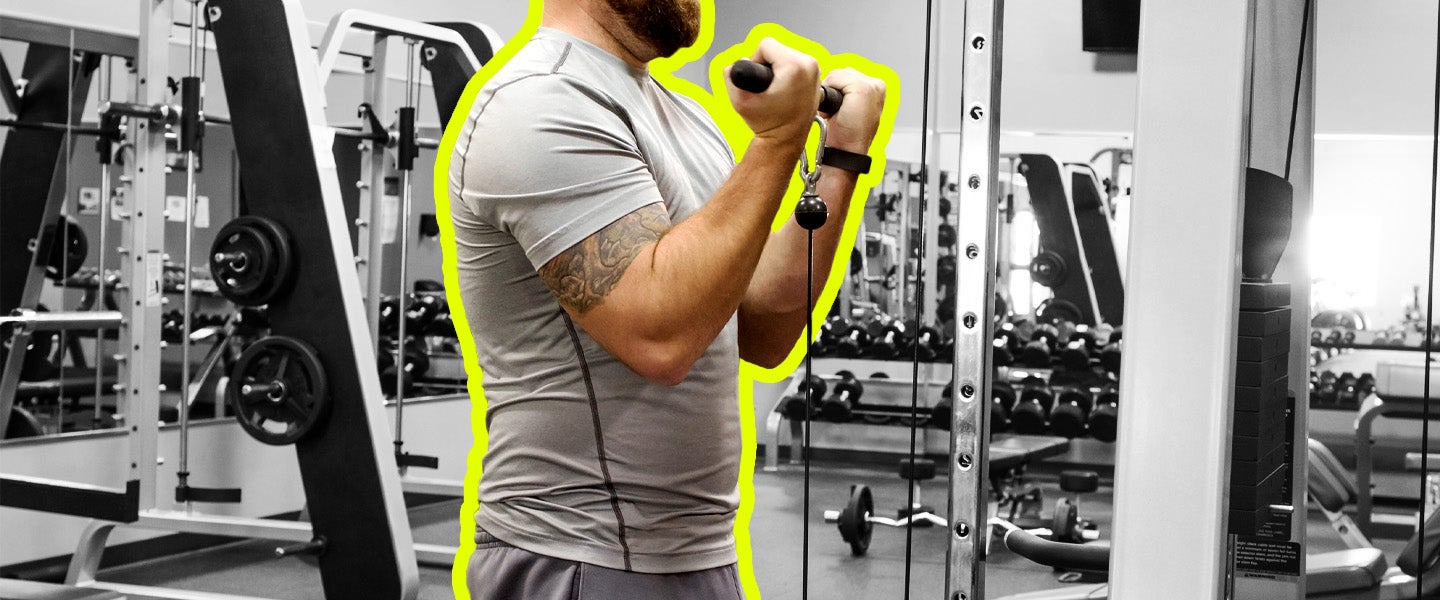Michael Camilleri, 24, entered the weight room at PureGym in London and did a double-take. Every guy was wearing the exact same thing: a gray T-shirt and black shorts. Camilleri, clad in all black, was the odd buff man out.
His fellow gym rats grunted on their machines looking like a pack of zebras in the unofficial zealous-workout-bro uniform. Camilleri snapped a photo and asked Twitter, “Did I miss a memo where all the chads at gym today have to wear grey.”
did I miss a memo where all the chads at gym today have to wear grey pic.twitter.com/BV7Al7zAes
— Mike ⚡️ (@MikeCam) January 14, 2020
Workout clothes are overwhelming. Each brand comes with a rigid personality. Lululemon says “I have a girlfriend who does yoga”; Outdoor Voices suggests you listen to a podcast while on the treadmill; a dingy Champion T-shirt says, “Come on, bro, let’s make some gains.” Each of these labels, though, offers a basic gray tee. “It’s an essential, definitely a gym go-to,” says Londoner Jesse Hansen. He appreciates a good gray gym shirt, especially when it’s on another man at the weight rack. “A guy’s chest always looks amazing in a gray shirt.”
You can find guys in gray on the NYC subway with bulky Nike body bags strewn across them. They’re on Instagram, sweat dripping down their soaked chest, veins bulging from their arms. Anecdotally, I can tell you that gray shirts are also a staple of LA Fitness in Elmhurst, Illinois.
R.J. Pavone, my college roommate and noted workout addict (we talked more at the gym than in our home), surveyed for gray shirts yesterday during his routine 5 p.m. workout. His findings: 17 men and only two women wore gray. “While there is a larger population of men in the gym than women, the gray shirt majority is definitely noticeable. I think this could be due to winter apparel being more muted in general,” Pavone says.
Interesting point, Joe. Did some field research today at the gym for ya pic.twitter.com/rGyYM39oTR
— RJ Pavone (@RonzoneProvlone) January 15, 2020
Black attracts heat, limiting one’s ability to wear it on a hike and in the weight room. White attracts stains, limiting one’s ability to look sexy on a hike and in the weight room. Gray, then, is the economic neutral of workout clothes. It’s a safe bet. “I realized half my workout shirts are gray, but they are mostly gifted to me by family or bought in a pinch,” TV writer Brenden Gallagher, 33, says.
I do, but only because all my workout shirts are old company promo shirts I don't care about anymore and many of them happen to be grey or white.
otherwise black all the way
— Brandon Echter (@bechter) January 15, 2020
I have a grey sweatshirt I wear but only because it's official Mission: Impossible: Fallout-branded merch I won
— Josh "Baby Yoder" Heath (@JoshAndHisJokes) January 15, 2020
Most of the men I spoke with echoed the importance of availability or intent when picking a shirt to wear while making gains. While the rise of athleisure aestheticized female workout presentation, straight men get a pass to sculpt their chests looking as schlubby as possible. “A lot of the flashy T-shirts aren’t what I’m looking to sweat in,” my brother Dan Longo tells me. A frugal man, he’s not paying for a high-end gym or buying from Beyoncé’s new Ivy Park collaboration with Adidas. He’s also not about to work out in a work polo. “Way too much laundry would need to be done. I work out in the crappy shirts I have,” he says.
One potential knock on the gray? They show sweat like nothing else. But maybe that’s a good thing. When you’re struggling to complete 100 push-ups and questioning if you ever could look like Zac Efron, an immediate energy boost is standing in front of the YMCA mirrors and seeing how much your shirt has darkened from sweat. “Makes me feel like I did a better job than if I were wearing a shirt where the results aren’t so immediately visible,” Nick Vega, reporter for the New York Post, says.
But a shirt sweat-o-meter can cut both ways. Around town, visible perspiration is less a measure of workout success and more a question of why the fuck are you so wet? “I’m a sweaty monster,” says New York-based actor Sean Doherty. He exclusively wears Thompson Tees undershirts with special absorption pads. In the gym, though, everyone is wet, so he’ll throw on an old Wicked T-shirt his roommate cut into a tank top. “We can all assume I’m gonna be sweaty, so I figure people can deal,” he says.
It’s not just sweating. Once you put on those gray sweatpants and head outside Bary’s Bootcamp, you’re suddenly rocking the dreaded gray-on-gray outfit. So some men, like Vox writer and noted Barry’s Bootcamp enthusiast Alex Abad-Santos, opts for black gym shorts. “I like contrast,” he says, noting he’s more focused on keeping his shorts at the right length. “Seven inches is the longest, but five inches is the sweet spot.” (Even straight guys know a shorter inseam is more flattering.)
the bad thing about this is that you can't wear grey sweatpants after without it looking like a groutfit. so … I go for black shirts.
— alex (@alex_abads) January 15, 2020
A gray T-shirt is popular at the gym because it’s entirely forgettable. But there’s an element of privilege at play here, too: Men are often praised for their unassuming style while women are admonished for following trends. Just look at the rise of Everlane, a brand of basic menswear (with a bevy of heather-gray options) that says, “Hey, I’m stable.” “Gray might be their subconscious way of seeming sleek but not wanting to grab too much attention,” Camilleri says after reflecting on the grayout at his gym.
Returning to the gym two days later, Camilleri intentionally left his basic T-shirts at home. “Being gay is already enough to make you care less about what others think of you,” he says. So he wore pink and took a selfie at the machines. Was it for the attention? Of course. His nuanced masculinity can’t be found in shades of gray.

